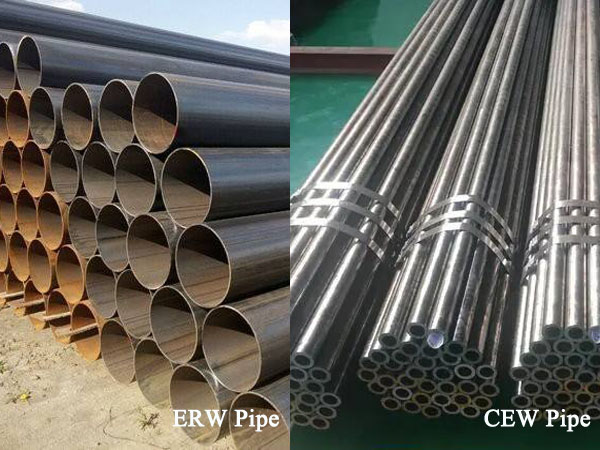
What is the Difference between ERW and CDW Pipes?
Welded tubes are cold drawn over mandrel when the application requires close dimensional resistance. They are called CEW tubes or CDW tubes. These tubes are broadly used in the automotive industry and furthermore to manufacture gears, special-purpose machines, hydraulic hardware, apparatus, and so forth. Much the same as seamless precision tubes, they too have low carbon content, are very flexible, reasonable for bowing. If required, these tubes will be toughened after being drawn, fixed, and experience a pickling procedure that gives it a fantastic flawless package process.
ERW Pipe VS. CEW Pipe: What's the Difference?
What are ERW and CEW?
ERW and CEW are both welding process types. ERW stands for electric resistance welding, while CEW stands for cold electric welding. Both methods use electricity to weld metals together, but they differ in how the electricity is used.

Difference between ERW and CEW steel pipes:
1. Manufacturing process
There are significant differences in the manufacturing processes of resistance welded pipe (ERW) and cold drawn electric welded pipe (CEW). ERW pipe is formed by heating a strip of steel and passing it through rollers to form it into a cylinder. An electric charge is then used to fuse the material, welding the edges together. In contrast, the CEW process involves pulling a heated steel rod through a die, creating a seamless tube. There are pros and cons to both methods, but it mainly depends on the specific application.
2. Strength and durability
One of the most critical factors when selecting pipe is its strength and durability. ERW pipe has a smooth surface finish and is generally stronger than CEW pipe. However, CEW pipes are more resistant to external stresses such as vibration and shock. They also have a higher durability limit, meaning they can withstand greater pressures and strains than ERW pipes.
3. Cost and availability
Another important factor when choosing pipe is its cost and availability. ERW pipes are generally less expensive than CEW pipes, which makes them more popular in the market. However, in some cases, the greater durability and durability of CEW pipe may justify the additional cost. It also depends on material availability, manufacturing costs and shipping costs, which may vary by supplier and location.
4. Maintenance
Pipeline maintenance and upkeep is critical to ensuring the longevity of your pipes. ERW and CEW pipes require little maintenance, but their regulations vary widely. ERW pipes may require coating or sealing since welds are more susceptible to rust and corrosion. In contrast, CEW pipe is seamless, which reduces the chance of corrosion and leaks. However, they require regular cleaning to remove impurities and prevent clogging.
The intended application is critical in determining the type of pipe required. ERW pipe is widely used in construction, water systems, and plumbing systems because it is affordable and easy to fabricate. CEW pipes, on the other hand, are suitable for high-pressure applications such as oil and gas transportation, hydraulic systems, and the automotive industry. They are the first choice in areas where reliability and durability are critical.
Which is better, ERW or CEW?
As for which process is better, there is no clear answer. Each has its advantages and disadvantages. ERW welding is faster and more economical, but may cause weld quality issues. CEW welding is slower and more expensive, but produces higher quality welds.
Clarifying common cognitive misunderstandings
1. "CEW pipe is seamless pipe": This is incorrect. CEW pipe uses ERW welded pipe as its base material and is essentially still a welded pipe, but the weld is invisible after cold drawing.
2. "ERW pipe cannot be used in high-pressure applications": one-sided. High-end ERW pipe (such as API 5L X70 grade) can withstand pressures exceeding 2850 psi after weld heat treatment and is suitable for medium-pressure oil and gas transportation.
3. "CEW pipe is too expensive to be practical":incorrect. In hydraulics, automotive, and other fields, CEW pipe can replace seamless pipe at a 20%-30% cost reduction while offering comparable performance.
Conclusion:
Choosing the right pipe for your application is critical to ensuring safe and efficient operation. Whether it is ERW or CEW pipe, they have unique advantages and disadvantages. By understanding the differences between the two, you can make an informed decision based on your needs and budget. It is necessary to consult a PMC carbon steel pipe manufacturer to help you evaluate the various options and select the pipe that best suits your requirements.
Tips: ASTM A53 Gr.B is the grade in ERW high frequency welded pipe, divided into A and B grades. API 5L Gr.B is also the American standard material, A53 GR.B ERW refers to the electric resistance welded steel pipe of A53 GR.B; API 5L GR.B Welded refers to the material Welded steel pipe of API 5L GR.B.ASTM is only a set of specifications. ASTM steel pipe A53 A corresponds to the Chinese standard GB8163 raw material is 10# steel, and A53 B corresponds to the Chinese standard GB8163 raw material 20#.
For example: ASTM (standard) A53 (grade) gr is grade (abbreviation of grade) b (grade B)


